
Don’t Skip the Security Review When Purchasing SaaS
Table of Contents ToggleThe Evolving Landscape of Employee Software PurchasesWeighing the...
Back
Back
Search for Keywords...
Blog

Table of Contents
Nowadays, SaaS subscriptions have all but replaced the old methods of buying software. It used to be that tech stacks had just a few software vendors that were purchased through IT. Meanwhile, employees can now purchase software on a monthly or yearly subscription, amounting to hundreds of vendors.
While SaaS subscriptions provide increased flexibility for businesses and enterprises, they also come with inherent risks. Without a central source of truth, these subscriptions quickly multiply, duplicate, and overlap. This often occurs as individual employees buy premium access to programs while incorrectly expensing or mislabeling them. This not only costs your organization money, but these unauthorized purchases (called Shadow IT) can open you up to security risks.
As the landscape of SaaS acquisition changes, it can be hard to keep up with the repercussions of employee software purchases.
Traditionally, financial risk has been the primary concern associated with shadow IT. Untracked, unapproved software purchases can drain resources as employees procure applications without IT’s knowledge or consent. This results in a scattered IT landscape, leading to inefficiencies, redundancies, and unnecessary costs. The financial implications encompass not only the cost of the software but also the potential expenses associated with integration, training, and support.
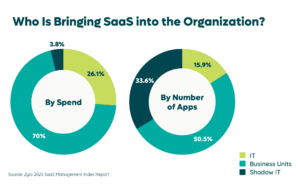
Yet, there’s hope. In fact, the report reveals a notable change in spending patterns. Employee SaaS purchases now account for just 3.8% of total spend. That’s a significant drop from the 7% recorded in 2022.
Clearly, organizations are making progress curbing unauthorized spending, redirecting resources to more strategic and approved software investments. Despite this progress, employee SaaS purchases still contribute to approximately 34% of the overall software stack.
While companies are becoming more aware of shadow IT, security risks still fly under the radar. In fact, 68% of expensed software have “Poor” or “Low” risk scores (based on the Netskope Cloud Confidence Index™ (CCI)). The average organization has 275 apps. That means nearly 200 apps are classified as shadow IT, which is pretty alarming. These applications may lack the necessary security protocols, making them susceptible to breaches, data leaks, and compliance issues.
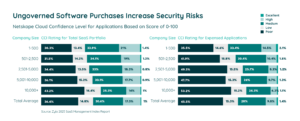
The repercussions of security risks extend far beyond the immediate financial impact, encompassing damage to the organization’s reputation, legal challenges, and potential loss of customer trust.
Without a comprehensive inventory of the software in use and constant monitoring of applications, organizations open themselves up to potential data breaches and noncompliance. The lack of visibility into the software ecosystem allows unauthorized applications to operate unnoticed, creating security vulnerabilities and increasing the likelihood of noncompliance with industry regulations.
Data breaches come with a substantial financial burden. As reported by IBM’s Cost of a Data Breach report, the average expenditure of a data breach in the United States is $4.88M. This figure encompasses the direct costs of resolving the breach, such as investigations, notifications, and recovery efforts, and indirect costs, including lost business opportunities and damaged brand reputation.
Data breaches erode trust in an organization. When sensitive information is compromised, customers may question the security measures, leading to a loss of confidence. The impact extends beyond the immediate breach, potentially affecting customer loyalty, acquisition, and overall satisfaction.
Data breaches often trigger legal consequences. Organizations may face legal challenges and regulatory penalties for failing to adequately protect sensitive information. Noncompliance with data protection laws can result in fines, legal battles, and tarnished legal standing, further exacerbating the financial and reputational fallout.
The consequences of shadow IT and data breaches affect the entire enterprise or business. Adverse publicity and media coverage can tarnish the brand image, making it challenging to regain trust. Customers, partners, and stakeholders may associate the brand with insecurity, leading to long-term reputational damage that extends well beyond the immediate aftermath of the breach.
“It’s easy to say, ‘I didn’t know.’ But when somebody reads about it in an article, it comes across like, ‘You don’t run a competent program. Clearly, you don’t know what you’re doing.’ Perception makes and breaks people and companies and reputation.”
— David Stoicescu, CISO
SaaS Management, specifically SaaS inventory management, is crucial in reducing the risks linked to employee software purchases. It’s a comprehensive approach that uses policies, tools, and strategies to see and control the organization’s software usage.
Beyond financial control, SaaS Management has become the bulwark of digital security. Even with reduced financial implications, the security risks associated with shadow IT remain substantial. According to Gartner, organizations that don’t centrally manage their SaaS life cycles are five times more susceptible to a cyber incident or data loss.
SaaS Management acts as a gatekeeper and lets you evaluate incoming applications based on security criteria. This ability minimizes the risk of data breaches, compliance issues, and other security threats.
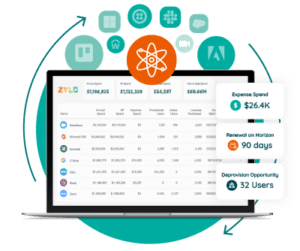 A SaaS Management Platform (SMP) enables a complete SaaS inventory, serving as the foundation for informed decision-making and shadow IT risk mitigation. By employing continuous monitoring through an SMP, your organization can swiftly identify vulnerabilities, security gaps, and unauthorized applications resulting from employee software purchases. This oversight allows proactive risk mitigation and provides a safeguard against potential threats.
A SaaS Management Platform (SMP) enables a complete SaaS inventory, serving as the foundation for informed decision-making and shadow IT risk mitigation. By employing continuous monitoring through an SMP, your organization can swiftly identify vulnerabilities, security gaps, and unauthorized applications resulting from employee software purchases. This oversight allows proactive risk mitigation and provides a safeguard against potential threats.
Having information is the first step in knowing what’s happening at all levels of your organization. What if you hear about a vulnerability in an application or across several? Do you know immediately if your company uses that software? If so, you should track down who bought it, what they use it for, and what information is accessible within the application. Only then can you take steps to mitigate or eliminate the security risks.
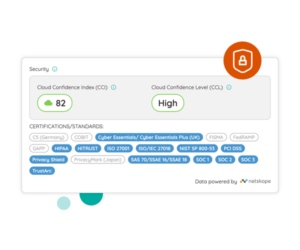
We help our customers categorize and tag SaaS applications so that you know immediately which ones contain PII or PCI. Knowing which applications are the most vulnerable helps IT managers remain vigilant. Now, whenever a new application enters your enterprise, Zylo notifies you immediately – so that you can take action.
It takes proactive measures to eliminate Shadow IT resulting from employee software purchases from your organization. These include a comprehensive inventory, a monitoring system, download alerts, and categorizations that identify PII or PCI. Once you implement a SaaS management system like the one Zylo offers, you can gain visibility into all of your IT applications and take appropriate actions to regulate them. Read our guide to learn how to eliminate Shadow IT and take back control of your SaaS stack.

Table of Contents ToggleThe Evolving Landscape of Employee Software PurchasesWeighing the...

Table of Contents ToggleThe Evolving Landscape of Employee Software PurchasesWeighing the...
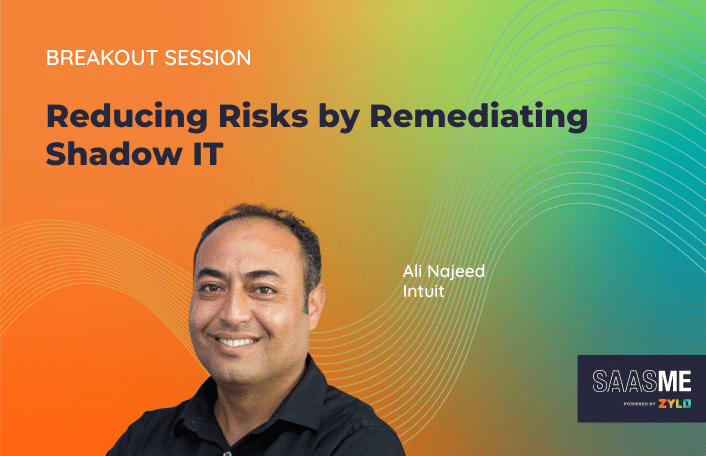
Table of Contents ToggleUnderstand Your SaaS FootprintCreate An Ongoing SaaS Management...

It’s every CIO’s dream: having a SaaS governance framework that enables...
| Cookie | Duration | Description |
|---|---|---|
| cookielawinfo-checkbox-analytics | 11 months | This cookie is set by GDPR Cookie Consent plugin. The cookie is used to store the user consent for the cookies in the category "Analytics". |
| cookielawinfo-checkbox-functional | 11 months | The cookie is set by GDPR cookie consent to record the user consent for the cookies in the category "Functional". |
| cookielawinfo-checkbox-necessary | 11 months | This cookie is set by GDPR Cookie Consent plugin. The cookies is used to store the user consent for the cookies in the category "Necessary". |
| cookielawinfo-checkbox-others | 11 months | This cookie is set by GDPR Cookie Consent plugin. The cookie is used to store the user consent for the cookies in the category "Other. |
| cookielawinfo-checkbox-performance | 11 months | This cookie is set by GDPR Cookie Consent plugin. The cookie is used to store the user consent for the cookies in the category "Performance". |
| viewed_cookie_policy | 11 months | The cookie is set by the GDPR Cookie Consent plugin and is used to store whether or not user has consented to the use of cookies. It does not store any personal data. |
